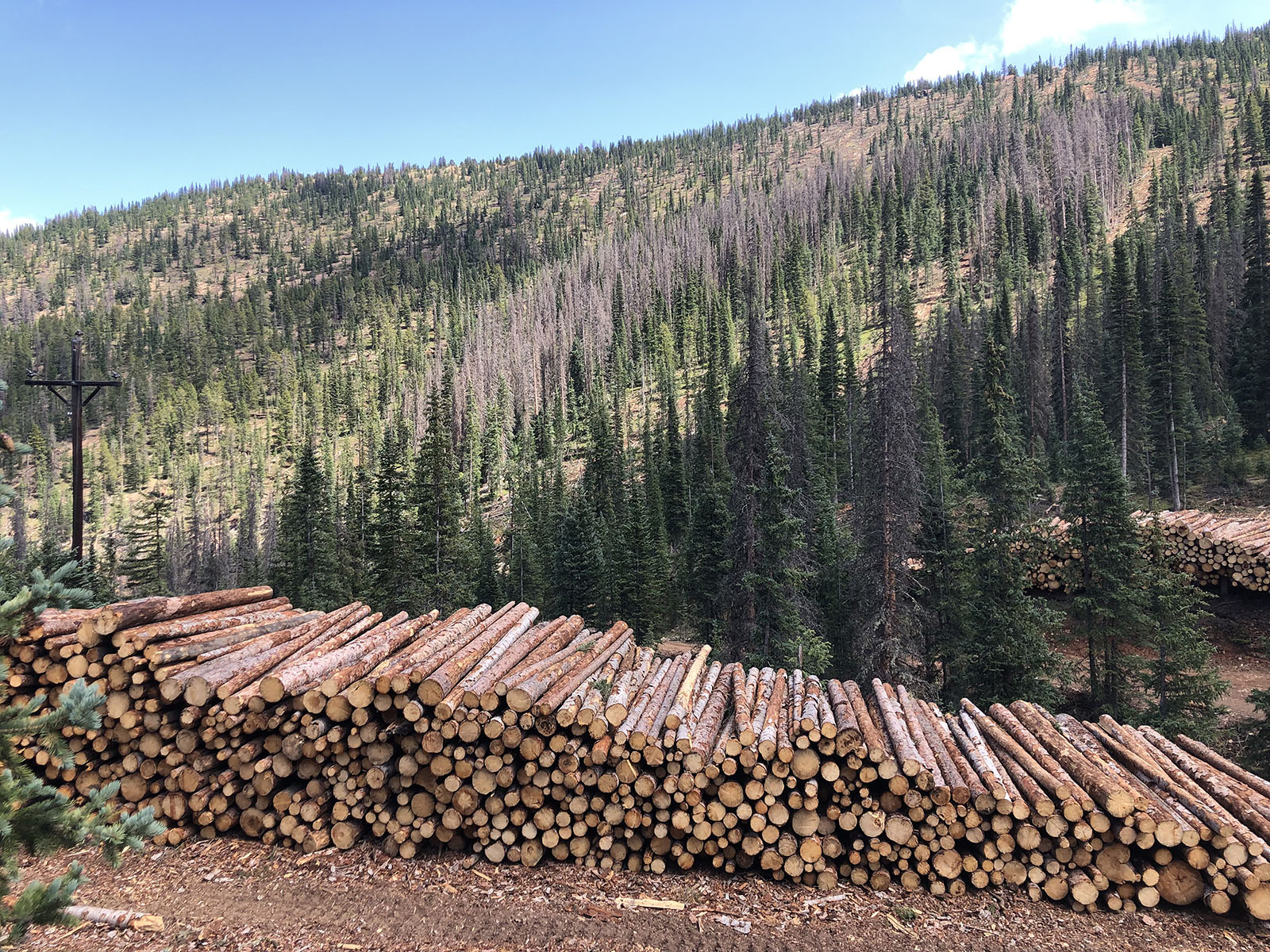Project salvages beetle-kill trees on steep slopes to reduce wildfire risk, protect water resources.
While the Upper Arkansas Valley has received plenty of rain this summer, smoke in the air has served as a reminder that the threat of wildfire is never far away, a situation made more urgent by the brown forest of beetle-kill trees around Monarch Pass. Thanks to a collaborative effort led by the U.S. Forest Service and the Arkansas River Watershed Collaborative (ARWC), the threat of catastrophic wildfire is lessening in the area.
With 90 percent of mature trees in the area killed by spruce beetles, the Monarch Pass Forest and Watershed Health Project is removing the dead trees to reduce the fuel load and the risk of catastrophic wildfire. The project employs new logging technology – cut-to-length, or CTL, equipment – to remove beetle-kill trees on steep slopes. Compared to traditional steep-slope logging methods, the CTL approach provides a more economical, less damaging method of harvesting timber.

The eight-wheeled CTL machines can operate on slopes as steep as 70 percent with the optional use of tracks and a tether. The eight wheels and tracks help reduce the impact to soils by spreading out the weight of the machinery. The tether is secured at the top of the slope and connected to a winch on the CTL machines. The winch assist, synched to the wheels, helps minimize soil damage by preventing spinning tires from digging into the ground.
“We’re trying to have the lightest touch possible,” said ARWC Lead Forester Andy Lerch, who manages the Monarch Pass project.
The CTL machines operate in pairs. First, a harvester descends the mountain slope, cutting a 60-foot swath of beetle-kill timber and leaving a mat of slash along its path to protect the soil from erosion. The harvester fells the trees one at a time ‒ delimbing the trunks, measuring them, cutting them to standard lengths, and sorting them according to different end uses for an efficient treatment process.
The harvester’s computer system analyzes each tree harvested, ensuring optimal usage of the timber and reducing the amount of unused material left in the forest. Once the harvester has turned the dead trees into sawmill-ready logs, a machine called a forwarder travels down the same paths to haul the presorted logs to a convenient location for loading onto trucks headed for the mills.

Lerch said the larger, higher-quality logs are being sold to sawmills, and the lower-quality logs are being sold for firewood. Utilizing the timber from this project helps to sustain the local forest industry. Having local markets for this timber is essential to the success of this project and is key to getting the dead trees off the mountain. The value from the timber helps to offset the cost of CTL forest management.
Lerch said protecting critical water resources is a major concern driving the Monarch Pass project. “We’re concerned about high-severity fire in our headwaters regions, which would affect water quality for everyone downstream.”
Cities and towns that rely on clean water from the Monarch Pass drainage include Salida, Poncha Springs, Colorado Springs and Pueblo, all of whom have contributed funding to support the project.
The thinning work is contracted to Oregon-based Miller Timber Services, which pioneered CTL timber harvesting in the Pacific Northwest. Matthew Mattioda, chief forester with Miller Timber Services, said, “This is an important project for the community and the downstream water users, and we are excited to be a part of the solution.”
Lerch said he’s impressed by how minimal the impacts are where the timber has been harvested. “The impacts are contained to the pathways used by the CTL machines.” The vegetation in the 60-foot swaths in between those paths remains largely undisturbed, he said, in part because, when the harvester cuts a tree, it prevents the tree from falling onto and damaging other trees, including the younger trees not affected by the beetle outbreak.
Those younger trees will remain on the mountainside “to help promote the next generation of the forest,” Lerch said. “Over time, the project area will change to a more natural look.” He also noted that he’s seen minimal erosion on the slopes treated last year in spite of a strong monsoon season, a testament to the “light touch” of the CTL equipment.
Given the steep slopes in the Monarch Pass forest treatment area, monitoring for erosion is an important component of the project. Chuck Rhoades, a watershed researcher with the Forest Service Rocky Mountain Research Station, is leading that effort.
Rhoades said his team has installed sediment fences on a number of corridors used by the CTL equipment. “Anytime there’s significant rain,” he said, “we sample.”
He mentioned a July 21 storm that dumped “a half inch of rain in 15 minutes that caused surface and rill erosion. We collected sediment in a few fences, but the initial findings did not show anything alarming. The harvesting operations place logging slash on the surface of most of the CTL trails, and that cover appears to reduce the amount of soil erosion.”
As a pilot project, the work at Monarch Pass is the first use of tethered CTL equipment in a national forest in Colorado. Lerch said the Rocky Mountain Research Station has established experimental plots in the treatment area to study the project, and the findings will improve foresters’ understanding of the benefits and impacts of this type of project.
More than a year into the work, the project is on track to achieve its purposes:
- Improve forest resiliency.
- Reduce beetle infestation.
- Reduce fuel loading to minimize the potential for wildfire and reduce wildfire impacts.
- Provide for firefighter and public safety.
- Improve watershed health.
- Protect infrastructure, including power transmission lines.
- Improve aquatic ecosystem health.
Prior to the Monarch Pass project, Forest Service personnel had said they would not send firefighters into the area to fight a fire because of the danger from the amount of dry fuel in the dead trees. But Lerch said professional firefighters who have seen the work done last year told him that they would be willing to fight fires in the treated area. “We’re giving firefighters tactical options,” Lerch said.
Benefits of the project for local communities, include:
- Protection of critical water supplies for drinking water and agriculture.
- Mitigation of catastrophic erosion in the event of a forest fire.
- Protection of water, power and transportation infrastructure.
- Economic development.
ARWC secured more than $600,000 in matching funds for the project from multiple partners, including $400,000 from the Colorado Water Conservation Board. Other monies came from the Upper Arkansas Water Conservancy District, the Pueblo Board of Water Works, Colorado Springs Utilities, Chaffee County, the City of Salida, the Town of Poncha Springs, and Trout Unlimited.
The Forest Service Salida Ranger District leveraged those funds to contribute over $1.2 million in Forest Service funding for the project. Along with wildfire mitigation work at Monarch Mountain resort, all possible fuels treatments will be completed over 1,600 acres of the headwaters of the South Arkansas River on Monarch Pass.
For 2021, Chaffee County contributed $50,000 through its Common Ground Program, which invests a portion of sales tax revenues to strengthen forest health and reduce wildfire danger. Visit ChaffeeCommonGround.org for more information.
Press release provided by ARWC, ArkCollaborative.org/.




